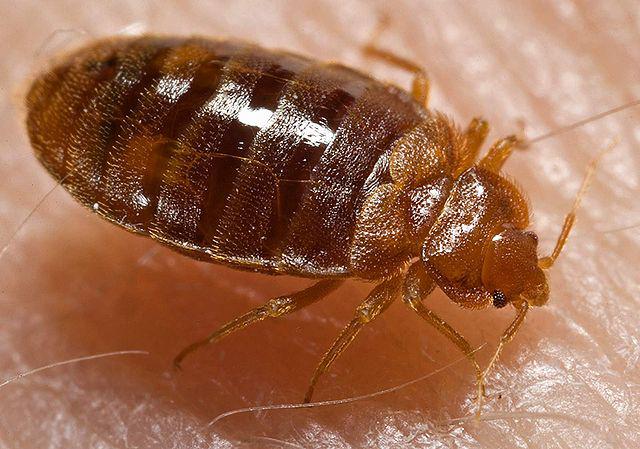Bed Bugs As Pests: Signs, Symptoms, Prevention and Control

What is a bed bug’s lifecycle?
Bedbugs find their way into your home through clothing, furniture, luggage and other items brought in from outside. Their flattened bodies help them crawl into the tiniest of spaces to avoid detection. These tiny oval shaped insects that are brown in colour feed on blood from humans and other warm-blooded animals.
Their bite may not be painful initially but might later cause skin irritation for some people.

Image source: http://en.wikipedia.org/wiki/Bed_bug – “Bed bug, Cimex lectularius” by Piotr Naskrecki
Being nocturnal, bed bugs only come out at night to feed – quite convenient huh? Anyway, it is this fact that makes them very hard to notice. You might have them in your home and not know it. There are ways however that you can identify a bed bug infestation.
Fecal matter on your mattresses and furniture is one of the tell-tale signs. Although they do not build nests, bed bugs seem to cluster together, with the cluster producing an unpleasant sweet smell. Blood stains on your bedding could also indicate an infestation.
(Source: http://www.webmd.com/skin-problems-and-treatments/guide/bedbugs-infestation)
View our bed bug control products >
What is a bed bug’s lifecycle?
Once the female mates – which involves a weird form of copulation called ‘traumatic insemination’ in which the male pierces the female’s abdomen and injects sperm into her body cavity – the female lays her eggs in sheltered locations. These locations include spaces under the baseboard, mattress seams and crevices in box springs. A female bed bug can lay about five eggs per day.
The laid eggs hatch in about four to twelve days. Out will emerge nymphs in their first instar. These nymphs will undergo five moults before maturing into adults. The nymphs, which resemble an adult bed bug but smaller, will require to feed before each moult.
Although bed bugs are parasites, both adults and nymphs don’t reside on the host’s body and will go back to their hiding spot once they have had their meal. It takes a bed bug between 5-10 minutes to fully feed. An adult bed bug will live for 6-12 months and can survive for extended periods without feeding.
(Source: http://www.cdc.gov/parasites/bedbugs/biology.html)
Bed Bug Symptoms
What are the common symptoms of a bed bug infestation. What tell tale signs do they leave behind in the morning light to indicate you have a bed bug problem?
One of the most obvious and glaring symptoms of a bed bug infestation is waking up in the morning with ugly red bites all over your skin, and possibly even small blood stains on your sheets. The bites are lumpy and get very itchy. They take weeks to heal.
However, that is not always the case. Sometimes, the bites may not appear for days after being bitten. At first, the bite might appear to be small, and will look like a mosquito or flea bite, but over time they will become a lot more inflamed, and very itchy.
But, there is a big difference in mosquito, flea or bed bug bites. Even though there are different types of mosquitoes and bites that they can give, the bites would normally go away after a few days. A flea bite would normally be around your ankles. And bed bug bites can be anywhere and will also get worse after a few days. The place where you would have been bitten will become larger, redder and more inflamed.
If you strip off the bed linen you can examine both it and the mattress itself. Even if you don’t see any live bugs, they leave behind their excrement, quite often found in or near the seams of the mattress.
Another common sign you might have bed bugs is a damp, musty odour like that of a wet towel. When you have many bed bugs, they leave this kind of stench behind.
They can be hard to find in the day, but do a search of the room anyway if you suspect bed bugs. Sometimes they’ll be hiding under your mattress, in the closet, or underneath skirting boards and in the carpet.
If you think you have a bed bug problem, either call in a specialist, or purchase Pestrol’s range of effective bed bug treatments to get rid of them.
How to control bed bugs?
Prevention is key to warding off a bed bug infestation: it’s easier and won’t require as much effort as dealing with a full blown infestation. Some of the things you can do to keep these bugs out are:
1. Closely examining any second-hand items before taking them into your house such as furniture, bedding and beds.
2. Keeping your luggage off the floor when travelling. Place it on something to prevent contamination.
3. Repairing cracks in your house and glueing down any loose wallpaper as these may provide hiding places for bed bugs.
4. Vacuuming your house regularly including furniture, walls, mattresses and other surfaces to get rid of eggs and mature bugs.
5. Isolating your luggage until you wash the clothes and bag. Make sure to dry them on the highest temperature for about fifteen minutes.
To help you prevent bed bug infestation and exterminate those that have already set up base in your home, Pestrol has developed a range of easy to use and effective products.
View our bed bug control products > займ на большую суммуэкспресс займ 24займ 5000 на карту





 Mosquito Traps
Mosquito Traps